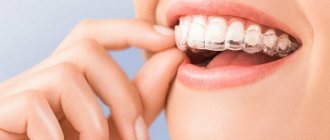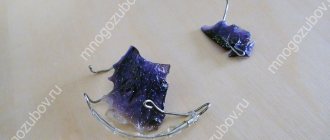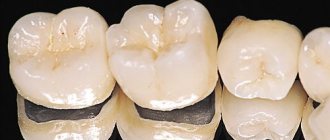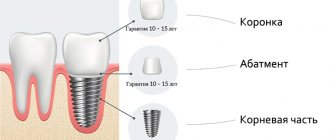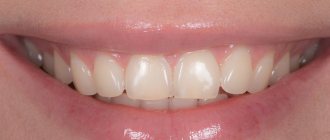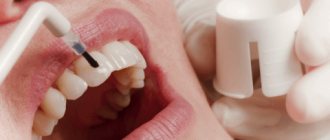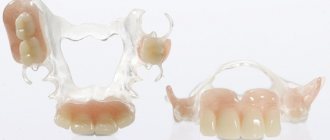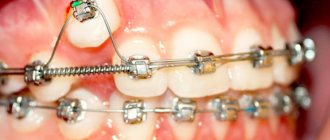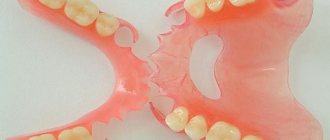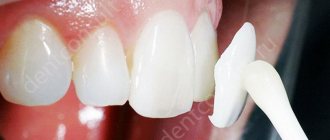Dental onlays are orthopedic mini-prostheses used to restore the aesthetics of the dentition. Dental restoration is usually carried out:
- for medical reasons (treatment, prevention of dental diseases, reconstruction of lost teeth);
- in order to restore the aesthetics of a smile.
To satisfy these needs, there are many ways in which dental restoration with onlays is carried out. In this article we will look at the most popular of them.
Composite onlays for teeth
Therapeutic, or composite, onlays for teeth are used in cases where the goal is to build up a badly damaged tooth, and not just improve aesthetics. For example, they can be used in case of severe chipping of the incisor (more than half the area) or in other cases when orthopedic veneers are simply useless due to the impossibility of their installation. Such dental overlays are made using the direct method, that is, immediately on the patient’s tooth, from composite materials, hence their name – composite veneers. Therapeutic overlays have a standard color range, so in some cases the patient cannot choose the appropriate shade. The advantage of this type of onlay is that the patient receives a visible result in one visit; in addition, the price of onlays for teeth made of a composite is significantly lower than classic ceramic veneers.
How to care for temporary veneers
Fragility is the main problem of short-term wear products. That is why dentists always specify rules of care and nutritional recommendations. Among them:
- refusal of hard and hard foods - nuts, apples, seeds;
- restrictions on the consumption of excessively hot and cold foods;
- using a toothbrush with soft bristles and toothpaste without whitening particles;
- rinsing the mouth with an antibacterial composition after each meal;
- reduction in vigorous activity – traumatic sports;
- use of a mouth guard if you have a diagnosis of bruxism.
Although plastic covers are only worn for a short period of time, proper care is a must. If the polymer breaks down or cracks during wear, the teeth underneath will suffer, which will lengthen the time of aesthetic restoration.
The quality of temporary and permanent veneers directly depends on the professionalism of the doctor and the capabilities of the dental clinic. This is why choosing a dentist is always very important. The beauty of teeth, the comfort and confidence of the patient depend on the doctor’s work. When choosing a dentist and a medical center, the 1dentist portal suggests focusing on independent ratings, the creation of which takes into account all patient reviews.
Overlays for crooked teeth
In some cases, dental onlays can be used to correct minor defects in the dentition. These include veneers, as their thickness allows you to hide imperfections. Overlays on teeth that are too thin, such as lumineers and ultraneers, will not cope with this task. You can use onlays for leveling only if the patient has a correct bite - installing such onlays on the teeth to solve the problem of correcting the bite will not bring any effect. They are helping:
- camouflage crooked teeth;
- correct too short teeth;
- get rid of a gummy smile (the problem is solved in combination with gum surgery);
- give a lifting effect to the cheekbones (when installing onlays on chewing teeth).
If significant adjustments are required, it is better to opt for ceramic onlays for teeth, as they are reliable and aesthetically pleasing. Composite veneers can be used to correct minor defects. The price of such dental overlays is significantly lower than the cost of ceramic veneers.
In addition to veneers, if teeth are slightly crowded, crowns can also be used - they help correct the curvature of one or more teeth. The disadvantage of this method of installing onlays on crooked teeth is the need to prepare healthy dental tissues, which not every patient will do. This method is considered quite aggressive. The advantages include quick results, in contrast to using a braces system.
Contraindications to the use of false teeth
Correcting and decorating teeth with onlays or attachments is not suitable for everyone. Dentists do not recommend resorting to such procedures when:
- inflammatory dental diseases accompanied by bleeding gums;
- diseases of the nervous system;
- allergic reaction to the materials used;
- the presence of bad habits - a tendency to grind teeth, chew hard objects and lack of proper hygiene skills.
Teeth onlays to correct bite
If the patient has no complaints about the enamel and is only interested in correcting crowded teeth, the doctor may suggest treatment with special mouthguards or aligners. Unlike fixed orthodontic structures, they can be removed during meals and during oral hygiene procedures. They are practically invisible on the teeth, as they are made of transparent material. Due to their tight fit to the dentition, removable onlays promote gradual teeth alignment. The disadvantage of treatment with mouthguards is their limited effect. If you have a complex case, then it is better to opt for aligners, which are as effective as braces.
Veneers
Veneers are ceramic plates used to restore the front row of teeth. They are installed on both the upper and lower teeth.
Veneers can eliminate many defects:
- crooked teeth;
- enlarged interdental gaps;
- chips and cracks;
- pigmentation or darkening of the enamel.
To fix veneers, it is necessary to grind a thin layer of enamel and secure them with special cement, which will securely hold the structure on the teeth. The service life of veneers is up to 15 years
. They do not require special care.
Aesthetic onlays for teeth
By “Hollywood” we mean a snow-white, even smile, which is associated with the smiles of movie stars - the generally accepted standard is four front teeth that are level with each other. In this case, the teeth must be large enough. In Russia, this concept simply means straight and white teeth. A similar result can be achieved in various ways. If, due to aesthetic defects, increased sensitivity or slight curvature of teeth, it is not possible to limit yourself to minimally invasive procedures, then cosmetic dental veneers are used. In aesthetic dentistry the following are used: veneers, ultraneers, compositers and lumineers. All of these types of aesthetic dental onlays are made in a dental laboratory using individual impressions of the patient’s teeth and then attached to the enamel surface.
In order to improve the aesthetics of the dentition, including hiding minor defects in the surface of the teeth, ceramic dental veneers are most often used, since this material is closest to the natural tooth enamel. The peculiarity of installing such onlays on teeth is that the procedure requires preliminary grinding of the enamel to the thickness of the veneer (0.3 - 0.7 mm). In addition, vinyl overlays for teeth are often used today; they are somewhat inferior to ceramic veneers in terms of characteristics, but are more affordable in cost. The number of plates installed may vary depending on the width of the smile. In cases where the teeth are severely damaged (less than 10% of the tissue remains) or there is a slight curvature of the dentition, crowns are used to achieve a Hollywood smile.
To achieve maximum strength, veneers are made of zirconium dioxide or aluminum (only the frame is made of metal, and the upper crown is made of ceramic), but in this case, the onlays on the teeth do not transmit light as well, so upon close examination the difference may be noticeable. In this regard, it is worth making an informed decision: either ceramic veneers for 5–8 years, or zirconium veneers for 15–20 years.
Crowns
With the help of crowns, chewing and frontal teeth are restored when they are so damaged that installing a filling is no longer possible. Crowns differ in the type of material they are made from.
Metal-ceramic crowns
They have a frame made of precious metals or nickel, cobalt-chrome. The top of the frame is covered with several layers of ceramic composition. Such crowns are quite reliable, however, they are not entirely aesthetic. Due to the metal frame, the tooth may look darker. In addition, an allergic reaction to the metal may occur.
Metal-plastic crowns
In this case, the metal frame is covered with a plastic mass. This significantly reduces the cost of the design and makes it lightweight. It is worth keeping in mind that the service life of a plastic product is not long. In addition, the coating is susceptible to staining and has low strength. Metal-plastic is used as a temporary solution to the problem.
Metal-free crowns
A fairly durable, reliable, aesthetic way to restore teeth. Most often they are used for the frontal region, as they have a similar transparency to their teeth. They are hypoallergenic and have ideal compatibility with soft tissues.
Zirconium dioxide crowns
The most durable and cost-effective method of dental prosthetics. Crowns are made from zirconium dioxide and a layer of ceramic is applied to the base. Used to restore all types of teeth.
White teeth whitening pads
If the goal is only to change the shade of the enamel, dentistry uses the thinnest white overlays on teeth made of composite, as well as in the form of lumineers and ultraneers. Teeth whitening with onlays in this way is suitable only for those who have healthy enamel (or is slightly damaged). The lightening procedure itself using such plates is called restoration bleaching. It is used when traditional types of whitening, such as home, laser, oxygen and Zoom whitening, do not work. During installation, the onlays are attached to the facial surface of the front teeth. Whitening plates are not installed on chewing teeth.
If desired, the patient can always contact the doctor with a request to change the plates to new ones (of a different color) or remove them completely. Moreover, the cost of installing such onlays on teeth will be significantly lower compared to other types of restoration.
The difference between an inlay and an onlay from a regular filling
Advantages of inlays and onlays over composite fillings
Accuracy
Durability
Aesthetics
Dental health in the future
Correct bite
Accuracy
An inlay or onlay is made using computer modeling, which means it reconstructs the tooth as accurately as possible.
Durability
The insert is more resistant to abrasion and lasts much longer.
Aesthetics
There is no loss of fit in the area of the inlay or onlay because the adhesion between the structure and your tooth is much stronger. This means that the border between the restoration and the tooth is absolutely invisible.
Dental health in the future
When inlays are created in the laboratory, their function is tested in an articulator (a special device that simulates the movement of the patient's jaws). Thus, the technician in the laboratory has the opportunity to restore all the lost cusps and fully restore the contacts that should be with the teeth of the opposite jaw. This ensures proper closure and prevents premature tooth wear.
Correct bite
Due to the strength of the material, which does not shrink, there is no cavity between the tooth and the restoration in which repeated caries can develop.
Tooth restoration using a composite filling
- The therapist models the filling directly in the oral cavity. His task is complicated by the presence of soft tissues, the presence of fluid in the mouth, the patient’s ability to lie with his mouth open, and limited time.
- A general practitioner does not have the conditions to accurately restore the anatomy of a tooth, which are available in a technical laboratory. During therapeutic tooth restoration, it is not possible to completely restore the relief and all the tubercles.
- The therapist is forced to do his work by eye, which does not give an entirely accurate result.
- In the future, the filling material, even if we hypothetically assume that everything is very accurately restored, will wear out over time.
- Perhaps the most important thing is when there is little tooth tissue left, and we restore them with filling material, then there is a possibility of the walls breaking off because sooner or later a violation of the fit will occur in the area between your tooth and the filling. Over time, the wall may break off.
Fabrication of prosthetic restorations in the laboratory
Composite restoration in the dentist's chair
Technique for installing onlays for restorative bleaching
Straight
– application of onlays on teeth made of composite material occurs directly on the enamel without preliminary production in the laboratory.
Indirect
– the thinnest (up to 0.3 mm) dental overlays are attached to the teeth – lumineers and ultraneers, pre-made in the laboratory individually based on a dental impression.
In addition to the listed methods, you can lighten the enamel by several shades using removable trays, which are used for whitening at home. They work due to a special whitening gel placed in the plate. You need to wear them for an average of an hour a day. But, unlike lumineers or composite veneers, it is not possible to accurately “predict” the result in advance, since it depends on the individual characteristics of the patient.
Indications for installation
All the solutions listed above are not alternatives to each other. With some exceptions, you cannot choose the option that you simply like best. Each of them is designed to solve specific problems and is used in certain cases. Indications may be as follows:
- Unsightly enamel color that cannot be removed with bleaching. For example, this may be yellowing due to smoking and taking certain medications, or white spots due to fluorosis.
- Enamel defects: chips, cracks. They not only make teeth and smile unsightly, but also increase their sensitivity, and this causes discomfort when eating, cold and hot drinks. By the way, small defects are sometimes covered with skys.
- Large spaces between teeth (threes). They can be corrected with braces. But not all people are ready to wear them. Overlays are much faster, they allow you to immediately get an excellent cosmetic effect.
- Crooked teeth. One of the options to correct this problem is to use overlay dentures. However, they have limited use when the deviations are small and do not affect the bite.
- Fillings that look ugly. Modern technologies allow you to choose the color of the filling material, like tooth enamel. But what to do if you had a filling a long time ago, it stands out a lot, spoils your appearance, you are embarrassed to smile because of it, and whitening does not help? In such cases, it is worth considering the option of veneers.
Jewelry on teeth
When your teeth are healthy, but you still want your smile to attract even more attention from others, patients turn to aesthetic dentistry to have onlays placed on their teeth for beauty: skys and grills.
Skyes
– decorative overlays on teeth, which are used to decorate the enamel or camouflage a small defect. These can be gold and silver overlays for teeth, as well as platinum and combined ones - using crystal, Swarovski crystals and precious stones.
Skyce installation is carried out using two methods. The first involves attaching the onlay directly to the tooth: a depression is made on the surface of the tooth, and the stone is fixed in it using a composite material. But inlay is a rare occurrence in dentistry, since not everyone wants to have an extra hole in a healthy tooth. In the second case, microprosthetics is used: the skye is installed on an onlay (veneer), previously made from an impression, then the onlay is attached to the tooth surface using filling materials. Such dental overlays help hide more serious enamel defects.
Grillz
– removable dental onlays, which are installed on both one and several front teeth. They are popular among celebrities and are usually quite expensive because they are custom-made from precious metals. Silver, gold and platinum dental overlays can be encrusted with diamonds, emeralds and rubies. However, grillz do not necessarily have to be made of gold or other precious metals. They can be made from inexpensive metals with rhinestones and not individually, but according to a template. In this case, the price for such dental overlays will be more affordable.
Ultraneers
These are dental onlays up to 0.5 mm
. They are used to restore the front row of teeth and are installed on both the lower and upper teeth. They are analogues of veneers and lumineers.
To fix ultraneers, teeth are not ground, which is an undeniable advantage. Ultraneers solve the following problems:
- darkening and pigmentation of enamel;
- small cracks;
- unequal shape and size of teeth;
- large dental gaps.
The service life of ultranir is up to 15 years
. Care - normal daily oral hygiene, professional hygienic cleaning in dentistry regularly.

